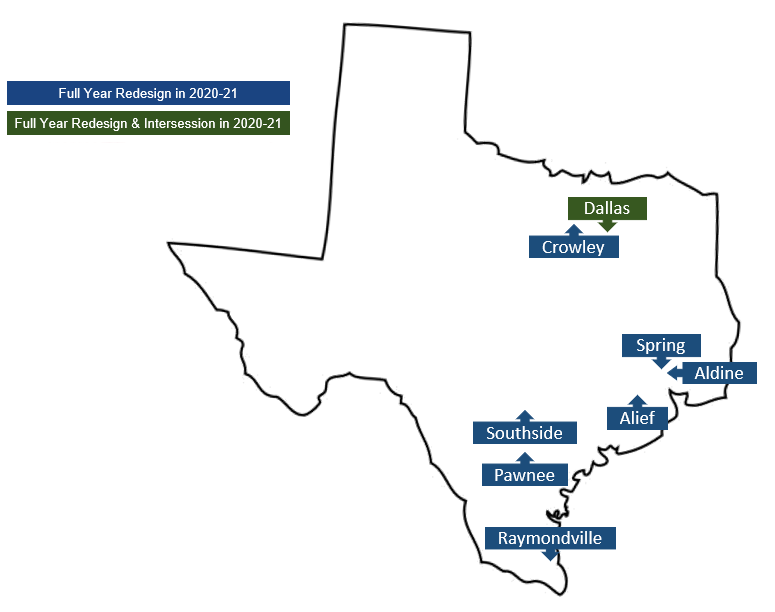District Profiles of ADSY Programs
Seven districts participated in ADSY PEP during the 2020-2021 school year to plan a 210-day school year (full year redesign) and launched their programs in summer 2021-2022! Separate from ADSY PEP, Dallas ISD launched an intersessional calendar in 41 elementary schools and full year redesign in five schools. Below you can read more about each of these districts and see select documents from their strategic plans.
Aldine ISD
Why ADSY: To close the achievement gap for economically disadvantaged, Hispanic, and African American students and create choice and opportunity for students and families.
What they are doing: Implementing a GRASP model so that students experience more project-based learning. Introducing four “showcase Saturday” community events that celebrate students’ work. Dedicating ~300 minutes per week for teacher planning, collaboration and professional development, two targeted intervention blocks, and increased recess time.
Artifacts: Academic Calendar | Student & Teacher Schedules
Alief ISD
Why ADSY: To empower teachers with effective instructional strategies that improve rigor and incorporate whole child supports.
What they are doing: Redesigning the master schedule with 90 minutes each week built in for teacher professional development, support, and collaboration. Introducing weekly blocks for enrichment activities that are aligned with core content and accelerate students’ learning.
Artifacts: Academic Calendar | Student & Teacher Schedules
Austin ISD
Why ADSY: To enhance COVID recovery efforts with a focus on re-engaging students and ensuring instructional support for teachers.
What they are doing: Leveraging “acceleration Fridays” to provide a combination of learning acceleration support and enrichment activities for students. Developing an instructional program that supports teachers in applying the Neurosequential Model in Education (NME), blended learning, and data-driven instruction. Building stakeholder buy-in from teachers and parents for a longer-term FYR strategy.
Crowely ISD
Why ADSY: To create an exciting new instructional program and school community as the campus transitions from only grades 5-6 to grades PK-5.
What they are doing: Bringing the best practices of dual language instruction through the Gomez and Gomez method into all instruction. Establishing a two-hour STEAM lab block on ADSY days to increase enrichment opportunities for students and planning time for teachers. Introducing new positions to serve students and support teachers, such as an Early Childhood Specialist, a Montessori Specialist, and a Dual Language Specialist.
Dallas ISD
Why ADSY: To act boldly in figuring out a plan to mitigate students’ learning loss that resulted from the disruption caused by the pandemic.
What they are doing: Adding approximately 10,000 additional minutes for students to make up missed learning, develop key social emotional competencies, and experience meaningful enrichment. Strategies vary by school but help provide time for teachers to lead small group instruction and engage in collaborative planning time with peers.
Artifacts: Academic Calendar (FYR #1, FYR #2, Intersession) | Communication Materials
Pawnee ISD
Why ADSY: To provide students with real world learning opportunities.
What they are doing: Partnering with community organizations and businesses to offer internships and vocational training to students. Providing students with enrichment activities focused on outdoor learning and the arts on designated ADSY Fridays. Creating more three-day weekends Fridays to mitigate teacher and student burnout.
Artifacts: Academic Calendar | Student & Teacher Schedules
Raymondville ISD
Why ADSY: To increase reading and math proficiency to 85 percent and to sustain a student attendance rate of 95 percent.
What they are doing: Incorporating brain breaks for students into the master schedule five days a week, and creating a 90-minute enrichment period on Fridays. Implementing ADSY in six classrooms across kindergarten and first grade before scaling up. Teachers have increased weekly planning to support instructional improvement.
San Marcos CISD
Why ADSY: To create relevant and rigorous learning experiences and multi-tiered systems of supports for students, and targeted professional development and collaboration for teachers.
What they are doing: Implementing a voluntary summer learning program available to all students while cultivating more buy-in from teachers and the community for full year redesign. Engaging teachers in targeted professional learning and data-driven instruction by developing campus instructional leaders. Enabling students to participate in project-based learning and enrichment activities of their choosing, as well as providing break breaks throughout the week.
Artifacts: Communication Materials
Southside ISD
Why ADSY: To create norms, instructional practices, and curricula at a recently opened early childhood center that align with district priorities and the redesigned calendar.
What they are doing: Adopting an aligned, rigorous, and engaging curriculum to support teachers in taking a hands-on, integrative approach to instruction. Offering enrichment opportunities to students, such as karate, folklore, and woodworking to students, and adding additional recess and outdoor learning time. Expanding family and community engagement efforts to include informational sessions, forums, web-based advertising, and local television commercials.
Spring ISD
Why ADSY: To help facilitate a larger shift towards making the schools technology-centered hubs.
What they are doing: Emphasizing coding, robotics, and computer technology during weekly student enrichment blocks. Increasing teacher collaboration and offering technology-based training for teachers through partnerships with Exxon Mobile and Prairie View A&M.
Artifacts: Academic Calendar


